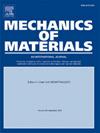Cu-Zr纳米玻璃的工艺-结构-力学性能关系:来自分子动力学的见解
IF 3.4
3区 材料科学
Q2 MATERIALS SCIENCE, MULTIDISCIPLINARY
引用次数: 0
摘要
纳米玻璃作为一种新型的微结构可调的非晶态材料,为非晶态材料的结构工程化和性能定制化铺平了道路。这项工作的核心是修改微观结构特征(通过改变加工路线),这是通过对工艺-结构-性能关系的全面理解而实现的。对天然气的研究经常局限于特定的加工参数,或者仅仅关注于确定趋势。本研究采用分子动力学模拟方法对Cu-Zr NGs的工艺-结构-力学性能关系进行了全面的研究。重点研究了温度、玻璃淬火速率、芯粒尺寸和成分等主要工艺参数对纳米玻璃结构特性和力学行为的影响。研究结果表明,温度、玻璃淬火速率和成分等工艺参数对原子体积分布和Voronoi簇的形成有很大影响。相反,晶粒尺寸特别影响组成相的体积分数。对不同工艺参数下天然气的力学响应分析表明,通常情况下,任何工艺参数都会导致过量的自由体积和松散的团簇,从而导致较低的极限强度和较软的弹性响应。此外,NGs的极限后拉伸强度行为和均匀塑性程度主要受晶粒尺寸的影响。此外,对变形机制的研究揭示了剪切激活原子成核、剪切转变区的激活和剪切局部化三个阶段。该研究结果为通过控制加工条件来提高机械性能的天然气材料设计奠定了基础,并在恶劣环境中提供了实际应用。本文章由计算机程序翻译,如有差异,请以英文原文为准。
Process-structure-mechanical property relationships in Cu-Zr nanoglass: Insights from molecular dynamics
Nanoglasses (NGs) as a novel type of amorphous material with tunable microstructure have paved the way for engineering the structure of amorphous materials with tailored performance. Central to this effort is modifying microstructural features (through altering processing routes), which is made possible by a comprehensive understanding of process-structure-properties relationships. Research on NGs has frequently limited its scope to specific processing parameters or focused solely on identifying trends. This study provides a comprehensive investigation of the process-structure-mechanical property relationships in Cu-Zr NGs by employing molecular dynamics simulations. It focuses on how main process parameters like temperature, glass quenching rate, core grain size, and composition affect NGs' structural characteristics and mechanical behavior. The findings indicate that process parameters such as temperature, glass quenching rate, and composition substantially affect atomic volume profiles and the formation of Voronoi clusters. Conversely, grain size specifically influences the volume fractions of the constituent phases. Analysis of NGs’ mechanical responses under diverse processing parameters reveals that generally, any process parameters that induce excess free volume along with loosely-packed clusters result in lower ultimate strength and a softer elastic response. Additionally, the post-ultimate tensile strength behavior and degree of homogeneous plasticity in NGs are primarily influenced by the grain size. Moreover, investigation of deformation mechanisms reveals three phases: the nucleation of shear-activated atoms, the activation of shear transformation zones, and the shear localization. The findings lay the groundwork for the material design of NGs with enhanced mechanical performance through controlling processing conditions, offering practical applications in harsh environments.
求助全文
通过发布文献求助,成功后即可免费获取论文全文。
去求助
来源期刊

Mechanics of Materials
工程技术-材料科学:综合
CiteScore
7.60
自引率
5.10%
发文量
243
审稿时长
46 days
期刊介绍:
Mechanics of Materials is a forum for original scientific research on the flow, fracture, and general constitutive behavior of geophysical, geotechnical and technological materials, with balanced coverage of advanced technological and natural materials, with balanced coverage of theoretical, experimental, and field investigations. Of special concern are macroscopic predictions based on microscopic models, identification of microscopic structures from limited overall macroscopic data, experimental and field results that lead to fundamental understanding of the behavior of materials, and coordinated experimental and analytical investigations that culminate in theories with predictive quality.
 求助内容:
求助内容: 应助结果提醒方式:
应助结果提醒方式:


